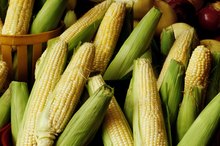Calcium Carbonate and Seashells
The ornate shells of marine organisms like mollusks are remarkable on any number of levels, not least in the intricate coloration they often exhibit. These calcium-carbonate structures also are remarkable for the transformation they can undergo under the right conditions, metamorphosing into one of the world’s most arresting and ornate rock types.
Calcium Carbonate
The chemical compound calcium carbonate is composed of calcium, carbon and oxygen. A simplified equation for its formation would be the addition of calcium, oxygen and carbon dioxide to form CaCO3, the chemical formula for calcium carbonate. A major source of the compound is marine organisms such as coral, shellfish and mollusks, which use it to construct their shells, or skeleton-like casing. The prototypical “seashell” is usually a mollusk's protective structure, such as a clam’s or oyster’s.
Shell Growth
Natural Source of Calcium Carbonate
Learn More
Mollusks usually build their shells in a trio of layers. The outermost band, the periostracum, derives mostly from protein, chiefly quinone-tanned protein but also some chitin, which makes up only a very small proportion of the total shell material. The inner layers are calcium-carbonate material. Specialized cells constitute the mantle tissue just beneath the shell, which produces the shell-creating material. The proteinous periostracum partly serves as a structural base for the mineralization of the calcium carbonate, which manifests as specific crystalline characters, or polymorphs, including calcite, aragonite or both. Due to the chemical conditions of modern-day seawater, aragonite tends to be the form into which calcium carbonate precipitates in many, though not all, marine organisms.
The Rock Cycle
Given enough time and pressure, layers of cemented shells and coral bodies may transform into limestone, a sedimentary, carbonate rock mainly composed of calcium carbonate precipitated by these organisms. These rocks that stem from such organic matter are called biogenic. As G.H. Dury notes in “An Introduction to Environmental Systems," limestone is a great storage reservoir of calcium carbonate, removing it – if only temporarily – from more active phases of precipitation and dissolution. Fairly resilient in the face of many forms of erosion, limestone is easily excavated by water laced with carbon dioxide. The wild formations that result, from convoluted caverns and caves to aboveground pillars and “stone forests,” are some of the most striking landscapes in the world. Great beds of limestone on land, such as those exposed in the Ozark Plateau, are phantom traces of ancient seaways.
As a Supplement
Specialized Cells in the Skeletal System
Learn More
Calcium carbonate is sometimes prescribed as a supplement for those whose diet is lacking in calcium, the body’s most abundant mineral and one of its most important. Other forms include calcium citrate and calcium lactate. Abnormally low levels of calcium can be detrimental to body function, as in the depletion of calcium reserves in the skeleton. However, many people are able to balance their calcium levels simply through careful consideration of diet.
Related Articles
References
- "An Introduction to Environmental Systems"; George Dury; 1981
- "On Biomineralization"; Heinz A. Lowenstam, Stephen Weiner; 1989
- "Scientific American"; Ask the Experts -- How are Seashells Created?; Francis Horne; October 2006
- Oregon State University, Linus Pauling Institute; Calcium; Jane Higdon, et al.; 2007
Resources
Writer Bio
Ethan Shaw is a writer and naturalist living in Oregon. He has written extensively on outdoor recreation, ecology and earth science for outlets such as Backpacker Magazine, the Bureau of Land Management and Atlas Obscura. Shaw holds a Bachelor of Science in wildlife ecology and a graduate certificate in geographic information systems from the University of Wisconsin.









